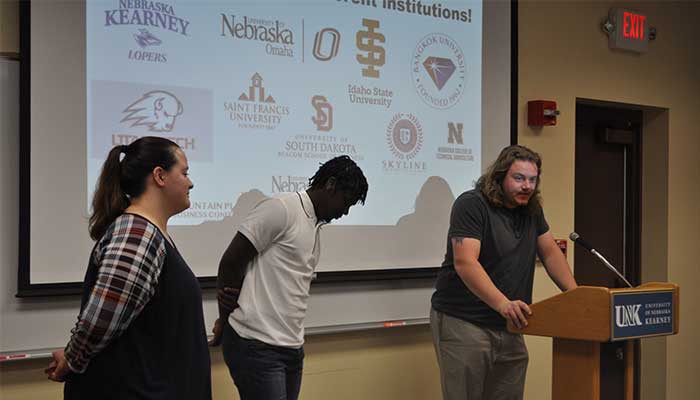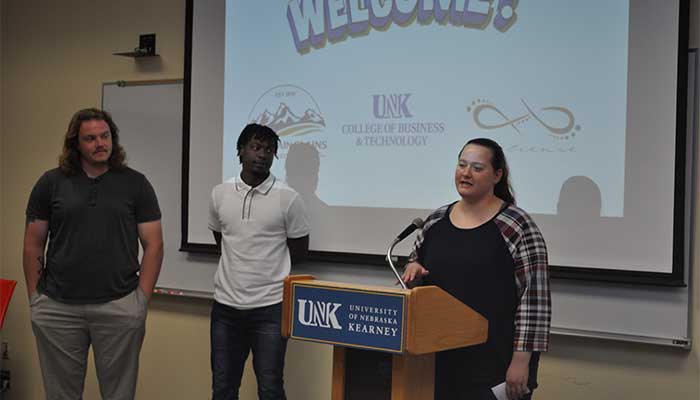You Can’t Get This Out of a Textbook
Posted: November 29, 2022 12:00:00 AM CST
When Dr. Daniel Chaffin taught MGT400-Entrepreneurship for the first time, he knew exactly what to expect from the textbook and his lesson plans. He was confident that his students would learn what they needed to know at the end of the semester. What he didn’t count on was the lesson that he would learn. Thanks to the feedback from one of his students, his class at the University of Nebraska at Kearney has left the confines of the classroom behind and spilled out all over the campus. These days, Chaffin wouldn’t have it any other way.
Like most professors, after teaching a class, Chaffin wanted feedback from his students. He anticipated having to tweak one or two things but never expected how one comment from an honest student would change his thoughts about what it really means to be an instructor. He read the feedback where the student “cut right to the heart of it” which ended up being a powerful experience for him as a teacher.
When he read that his student had anticipated the class would give him the skills to run a business one day, Chaffin knew he had to find a new way to teach the course. This caused him to throw out the textbook and brainstorm ways to create situations where students could only pass his class if they gained the necessary knowledge to run their own businesses.
When students enter Chaffin’s class these days, they quickly figure out that their professor does less talking than most. By giving up his time behind the lectern, Chaffin has created an environment where his students “do a whole lot more doing.” After all, what better way to learn how to run a business than to create and run one?
Class no longer consists of students operating in silence as they complete individual assignments. Thanks to the way Chaffin has completely overhauled his class, the students now “work as a team” to create and run their businesses. That student from years ago wished he had known how to run a business after taking one college class. Thanks to him, every student who completes MGT400 can add business owner to their college repertoire.
What takes place in Chaffin’s class isn’t combined group work. Students don’t have the option of simply dividing the work so each can complete their part. They quickly find out that the class is designed to make them accountable to each other as well as to their customers. For example, when the marketing person needs to work on their ads, they first need to find out the details of the product from the operations person. This level of interdependence perfectly mimics what these UNK students will soon do after graduation when they enter the real world of business.
Running a simulation of a business would be a fun project in any class, but this isn’t what Chaffin offers his students. They experience both the stress and the thrill that all entrepreneurs know as a way of life. After all, they turn in a business plan as well as a financing pitch to get their seed money before asking 100 potential customers if they would buy their product. They then have to figure out how to turn it all into a profitable business, a profit that will be donated to the campus cause of their choice at the end of the semester. They’re required to prove to Chaffin that they have “evidence of three different distribution channels” before they start collecting materials and handling products. In addition to creating websites and figuring out how to get their products in front of potential customers, these students write frequent reflective pieces where they explore what they’re learning about themselves, their group, and entrepreneurship in general. Chaffin admits he loves “watching how there’s feeling in it” as his students take what could be a straightforward class and turn it into something that becomes real to them. He recalls the words of a student who reached out before his business’s launch day to tell him, “I have hardly slept the last two nights. I’m so stressed.” Realizing the level of commitment that student was feeling made Chaffin understand he had made the right decision when he ditched the textbook after teaching the class for only one semester. He loves that the students have the choice to think up their own ideas for their businesses, a fact that makes them take a significant degree of ownership for their learning.
As for Chaffin, teaching this way has “made (him) make friends across campus” since having his students leave the comfort of the classroom affected him as well. One of his first steps with this new way of teaching was to create a panel of experts to make sure everything was done right. By reaching out to his peers in the areas of finance, risk management, student life, facilities, and more, he makes sure to get the input his students need to experience success. The panel does more than preapprove the business plans of his students; they stick around for the entire process, seeing each group’s final presentation.
Chaffin loves the way his course has come alive for his students. As a 400-level course with no prerequisites, it’s a diverse class. Having students from across campus means there are non-business majors mixed in with the traditional business students. He shares that these non-business majors “add a dose of creativity” to his class, affecting the way he chooses his groups. Just like his groups are all different, Chaffin admits he has no idea what will happen in his class from semester to semester. This dose of reality, one that he didn’t experience the first time he taught this class, has added an element of surprise which helps keep his students engaged.
When asked about his future plans for MCT400, he has what he terms “the wild idea” of combining what he’s doing in the classroom with what other professors are doing in the field of industrial technology. Not only does he want to expand the parameters of the coursework, but he would like to find a way to give his students “more of a spotlight platform.” After all, thanks to the way his teaching style has changed, his class mirrors real life. Impressed with what he has seen his students accomplish, he would “love to give them a little bit more of a megaphone.”
Dr. Daniel Chaffin has created an environment where, at the end of the semester, he has watched his students learn to work as a team, has watched them experience that certain “nuance that you can’t get out of a book,” and has gained the confidence that they are ready to launch. His hope with this new way of teaching is that his students have learned to take risks. He spends the semester encouraging them to have the courage to “move forward even though (they’re) not sure” about everything. He knows “wonderful things can happen” for them after graduation. In MGT400, Chaffin gives them a little taste of the great things to come as they pursue their entrepreneurial goals.









